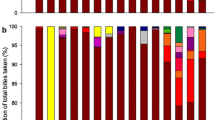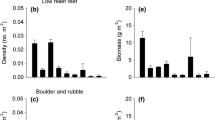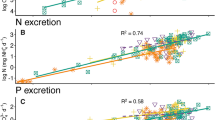Abstract
Dietary preferences of grazers can drive spatial variability in top-down control of autotroph communities, because diet composition may depend on the relative availability of autotroph species. On Caribbean coral reefs, parrotfish grazing is important in limiting macroalgae, but parrotfish dietary preferences are poorly understood. We applied diet-switching analysis to quantify the foraging preferences of the redband parrotfish (Sparisoma aurofrenatum). At 12 Caribbean reefs, we observed 293 redband parrotfish in 5-min feeding bouts and quantified relative benthic algal cover using quadrats. The primary diet items were macroalgal turfs, Halimeda spp., and foliose macroalgae (primarily Dictyota spp. and Lobophora spp.). When each resource was evaluated independently, there were only weak relationships between resource cover and foraging effort (number of bites taken). Electivity for each resource also showed no pattern, varying from positive (preference for the resource) to negative (avoidance) across sites. However, a diet-switching analysis consisting of pairwise comparisons of relative cover and relative foraging effort revealed clearer patterns: parrotfish (a) preferred Halimeda and macroalgal turfs equally, and those two resources were highly substitutable; (b) preferred Halimeda to foliose macroalgae, but those two resources were complementary; and (c) also preferred turf to foliose macroalgae, and those resources were also complementary. Thus parrotfish grazing rates depend on relative, not absolute, abundance of macroalgal types, due to differences in substitutability among resources. Application of similar analyses may help predict potential changes in foraging effort of benthic grazers over spatial gradients that could inform expectations for reef recovery following the protection of herbivore populations.






Similar content being viewed by others

References
Abrams PA (1990) Mixed responses to resource densities and their implications for character displacement. Evol Ecol 4:93–102
Abrams PA (1993) Why predation should not be proportional to predator density. Ecology 74:726–733
Abrams PA, Matsuda H (2003) Population dynamical consequences of reduced predator switching at low total prey densities. Popul Ecol 45:175–185
Adam TC, Burkepile DE, Ruttenberg BI, Paddack MJ (2015) Herbivory and the resilience of Caribbean coral reefs: knowledge gaps and implications for management. Mar Ecol Prog Ser 520:1–20
Augustin DJ, McNaughton SJ (1998) Ungulate effects on the species composition of plan communities: herbivore selectivity and plant tolerance. J Wildlife Manag 62:1165–1183
Bates D, Mächler M, Bolker B, Walker S (2015) Fitting linear mixed-effects models using lme4. J Stat Soft 67:1–48
Behmer ST, Joern A (2008) Coexisting generalist herbivores occupy unique nutritional feeding niches. Proc Natl Acad Sci USA 105:1977–1982
Bellwood DR, Hughes TP, Folke C, Nyström M (2004) Confronting the coral reef crisis. Nature 249:827–833
Bruggemann JH, van Oppen MJH, Breeman AM (1994a) Foraging by the stoplight parrotfish Sparisoma viride. I. Food selection in different, socially-determined habitats. Mar Ecol Prog Ser 106:41–55
Bruggemann JH, Begeman J, Bosma EM, Verburg P, Breeman AM (1994b) Foraging by the stoplight parrotfish Sparisoma viride. II. Intake and assimilation of food, protein and energy. Mar Ecol Prog Ser 106:57–71
Burkepile DE, Hay ME (2008) Herbivore species richness and feeding complementarity affect community structure and function on a coral reef. Proc Natl Acad Sci USA 105:16201–16206
Burkepile DE, Hay ME (2009) Nutrient versus herbivore control of macroalgal community development and coral growth on a Caribbean reef. Mar Ecol Prog Ser 389:71–84
Burkepile DE, Hay ME (2010) Impact of herbivore identity on algal succession and coral growth on a Caribbean reef. PLoS One 5:1–9
Burkepile DE, Hay ME (2011) Feeding complementarity versus redundancy among herbivorous fishes on a Caribbean reef. Coral Reefs 30:351–362
Byrnes J, Stachowicz JJ, Hultgren KM, Hughes AR, Olyarnik SV, Thornber CS (2006) Predator diversity strengthens trophic cascades in kelp forests by modifying herbivore behaviour. Ecol Lett 9:61–71
Carpenter SR, Kitchell JF (1984) Plankton community structure and limnetic primary production. Am Nat 124:159–172
Catano LB, Gunn BK, Kelley MC, Burkepile DE (2015) Predation risk, resource quality, and reef structural complexity shape territoriality in a coral reef herbivore. PLoS ONE 10:e0118764
Cheal AJ, MacNeil MA, Cripps E, Emslie MJ, Jonker M, Schaffelke B, Sweatman H (2010) Coral–macroalgal phase shifts or reef resilience: links with diversity and functional roles of herbivorous fishes on the Great Barrier Reef. Coral Reefs 29:1005–1015
Clements KD, Raubenheimer D, Choat JH (2009) Nutritional ecology of marine herbivorous fishes: ten years on. Funct Ecol 23:79–92
Crossman DJ, Choat JH, Clements KD (2005) Nutritional ecology of nominally herbivorous fishes on coral reefs. Mar Ecol Prog Ser 296:129–142
Dunlap M, Pawlik JR (1996) Video-monitored predation by Caribbean reef fishes on an array of mangrove and reef sponges. Mar Biol 126:117–123
Foster NL, Box SJ, Mumby PJ (2008) Competitive effects of macroalgae on the fecundity of the reef-building coral Montastraea annularis. Mar Ecol Prog Ser 367:143–152
Francini-Filho RB, Ferreira CM, Oliveira E, Coni C, de Moura RL, Kaufman L (2010) Foraging activity of roving herbivorous reef fish (Acanthuridae and Scaridae) in eastern Brazil: influence of resource availability and interference competition. J Mar Biol Ass UK 90:481–492
Harris JL, Lewis LS, Smith JE (2015) Quantifying scales of spatial variability in algal turf assemblages on coral reefs. Mar Ecol Prog Ser 532:41–57
Hay ME, Fenical W (1987) Marine plant-herbivore interactions: the ecology of chemical defense. Ann Rev Ecol Syst 19:111–145
Hay ME, Kappel QE, Fenical W (1994) Synergisms in plant defenses against herbivores: interactions of chemistry, calcification, and plant quality. Ecology 75:1714–1726
Hughes TP, Baird AH, Bellwood DR, Card M, Connolly SR, Folke C, Grosberg R, Hoegh-Guldberg O, Jackson JBC, Kleypas J, Lough JM, Marshall P, Nyström M, Palumbi SR, Pandolfi JM, Rosen B, Roughgarden J (2003) Climate change, human impacts, and the resilience of coral reefs. Science 301:929–933
Hughes TP, Bellwood DR, Folke CS, McCook LJ, Pandolfi JM (2007) No-take areas, herbivory and coral reef resilience. Trends Ecol Evol 22:1–3
Lechowicz MJ (1982) The sampling characteristics of electivity indices. Oecologia 52:22–30
Lefcheck JS (2015) piecewiseSEM: Piecewise structural equation modeling in R for ecology, evolution, and systematics. Methods Ecol Evol 7:573–579
Loh T-L, Pawlik JR (2014) Chemical defenses and resource trade-offs structure sponge communities on Caribbean coral reefs. Proc Natl Acad Sci USA 111:4151–4156
Loh T-L, McMurray SE, Henkel TP, Vicente J, Pawlik JR (2015) Indirect effects of overfishing on Caribbean reefs: sponges overgrow reef-building corals. PeerJ 3:e901
Lourenço SO, Barbarino E, De-Paula JC, Pereira LOS, Lanfer Marquez UM (2002) Amino acid composition, protein content and calculation of nitrogen-to-protein conversion factors for 19 tropical seaweeds. Phycol Res 50:233–241
McDermid KJ, Stuercke B (2003) Nutritional composition of edible Hawaiian seaweeds. J Appl Phycol 15:513–524
Miller AD, Roxburgh SH, Shea K (2011) How frequency and intensity shape diversity-disturbance relationship. Proc Natl Acad Sci USA 108:5643–5648
Mumby PJ (2009) Herbivory versus corallivory: are parrotfish good or bad for Caribbean coral reefs? Coral Reefs 28:683–690
Mumby PJ, Wabnitz C (2002) Spatial patterns of aggression, territory size, and harem size in five sympatric Caribbean parrotfish species. Environ Biol Fish 63:265–279
Murdoch WW (1969) Switching in general predators: experiments on predator specificity and stability of prey populations. Ecol Monogr 39:335–354
Nakagawa S, Schielzeth H (2013) A general and simple method for obtaining R 2 from generalized linear mixed-effects models. Methods Ecol Evol 4:133–142
Norström AV, Nyström M, Lokrantz J, Folke C (2009) Alternative states on coral reefs: beyond coral–macroalgal phase shifts. Mar Ecol Prog Ser 376:295–306
Oaten A, Murdoch WW (1975) Switching functional response and stability in predator-prey systems. Am Nat 109:299–318
Olff H, Ritchie ME (1998) Effects of herbivores on grassland plant diversity. Trends Ecol Evol 13:261–265
Paul VJ, van Alstyne KL (1988) Chemical defense and chemical variation in some tropical Pacific species of Halimeda. Coral Reefs 6:263–269
Pawlik JR, Burkepile DE, Vega Thurber R (2016) A vicious circle? Altered carbon and nutrient cycling may explain the low resilience of Caribbean coral reefs. Bioscience 66:470–476
R Core Team (2016) R: a language and environment for statistical computing. R Foundation for Statistical Computing, Vienna, Austria. https://www.R-project.org
Raubenheimer D, Simpson SJ (2003) Nutrient balancing in grasshoppers: behavioural and physiological correlates of dietary breadth. J Exp Biol 206:1669–1681
Raubenheimer D, Simpson SJ, Mayntz D (2009) Nutrition, ecology and nutritional ecology: toward an integrated framework. Funct Ecol 23:4–16
Rindorf A, Gislason H, Lewy P (2006) Prey switching of cod and whiting in the north sea. Mar Ecol Prog Ser 325:243–253
Rotjan RD, Dimond JL (2010) Discriminating causes from consequences of persistent parrotfish corallivory. J Exp Mar Biol Ecol 390:188–195
Scharf FS, Juanes F, Sutherland M (1998) Inferring ecological relationships from the edges of scatter diagrams: comparison of regression techniques. Ecology 79:448–460
Simpson SJ, Raubenheimer D (2001) A framework for the study of macronutrient intake in fish. Aquac Res 32:421–432
Simpson SJ, Sibly RM, Lee KP, Behmer ST, Raubenheimer D (2004) Optimal foraging when regulating intake of multiple nutrients. Anim Behav 68:1299–1311
Steneck RS, Dethier MN (1994) A functional group approach to the structure of algal-dominated communities. Oikos 69:476–498
Suding KN, Gross KL, Houseman GR (2004) Alternative states and positive feedbacks in restoration ecology. Trends Ecol Evol 19:46–53
Targett NM, Arnold TM (1998) Predicting the effects of brown algal phlorotannins on marine herbivores in tropical and temperate oceans. J Phycol 34:195–205
Targett TE, Targett NM (1990) Energetics of food selection by the herbivorous parrotfish Sparisoma radians: roles of assimilation efficiency, gut evacuation rate, and algal secondary metabolites. Mar Ecol Prog Ser 66:13–21
van Leeuwen E, Brännström Å, Jansen VAA, Dieckmann U, Rossberg AG (2013) A generalized functional response for predators that switch between multiple prey species. J Theor Biol 328:89–98
Vanderploeg HA, Scavia D (1979) Calculation and use of selectivity coefficients of feeding: zooplankton grazing. Ecol Model 7:135–149
Visser A, Fiksen Ø (2013) Optimal foraging in marine ecosystem models: selectivity, profitability and switching. Mar Ecol Prog Ser 473:91–101
Acknowledgements
We thank W. Freshwater for advice on algal biology and helpful comments on the manuscript, and T.-L. Loh, S. McMurray, L. Deignan, I. Conti-Jerpe, M. Marty, A. Dingeldein, and C. Marino for assistance in the field. We also acknowledge the staff at UNCW and NURC for logistical support. Constructive suggestions from two anonymous reviewers improved the manuscript.
Author contribution statement
JH and JRP conceived and designed the study. JH collected the data. JH and JWW analyzed the data. JH, JWW, and JRP wrote the manuscript.
Author information
Authors and Affiliations
Corresponding author
Ethics declarations
Funding
This study was funded by the National Science Foundation (OCE-0550468, 1029515).
Conflict of interest
The authors declare that they have no conflict of interest.
Ethical approval
All applicable institutional and national guidelines for the care and use of animals were followed.
Additional information
Communicated by Craig A. Layman.
Electronic supplementary material
Below is the link to the electronic supplementary material.
Rights and permissions
About this article
Cite this article
Hanmer, J., White, J.W. & Pawlik, J.R. Application of diet theory reveals context-dependent foraging preferences in an herbivorous coral reef fish. Oecologia 184, 127–137 (2017). https://doi.org/10.1007/s00442-017-3855-y
Received:
Accepted:
Published:
Issue Date:
DOI: https://doi.org/10.1007/s00442-017-3855-y



